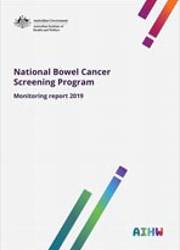Summary
The National Bowel Cancer Screening Program (NBCSP) began in 2006. It aims to reduce the morbidity and mortality from bowel cancer by actively recruiting and screening the eligible target population, aged 50–74, for early detection or prevention of the disease. This monitoring report is the fourth to examine the NBCSP using new key performance indicators.
In 2019, it is estimated that about 8,000 people aged 50–74 will be diagnosed with bowel cancer (approximately 49% of all bowel cancers diagnosed) and 2,000 people aged 50–74 will die from bowel cancer (approximately 35% of all bowel cancer deaths).
Participation
Of the 4.1 million people invited between January 2016 and December 2017, 41% participated in the program. The national participation rate was the same as for the previous rolling 2-year period (2015–2016) (41%). The re-participation rate for people who had taken part in their previous invitation round and were receiving a subsequent screening invitation was 78%.
Screening results
In 2017, about 69,000 Australians returned a positive screening test, giving an 8% screening positivity rate. Of the people who received a positive screening test, 66% had reported a follow-up diagnostic assessment. The median time from positive screening test result to diagnostic assessment was 52 days.
Cancers and adenomas detected
As form return is not mandatory, diagnostic assessment data were not considered complete enough to allow formal performance indicator reporting. However, of the data available for participants who had a diagnostic assessment in 2017, 1 in 29 were diagnosed with a confirmed or suspected cancer (266 and 1,318, respectively) and adenomas were diagnosed in a further 5,237 participants (1 in 9 participants assessed). Adenomas are benign growths that have the potential to become cancerous; their removal lowers the risk of future bowel cancers in these participants.
Population groups
Participants who identified as being of Aboriginal or Torres Strait Islander origin, lived in Very remote areas, and those who lived in low socioeconomic areas all had higher rates of positive screens (warranting further assessment), but had lower rates of follow-up diagnostic assessment, and a longer median time between a positive screen and assessment.
Since the NBCSP began
Since the program began in August 2006, about 5.5 million NBCSP screening tests have been completed, with about 280,000 participants having a diagnostic assessment to follow up a positive screening result. From the data available for participants who have had diagnostic assessment, 1 in 29 have been diagnosed with a confirmed or suspected cancer and 1 in 8 have had an adenoma detected. Previous data linkage studies by the Australian Institute of Health and Welfare found that the NBCSP is contributing to reducing morbidity and mortality from bowel cancer in Australia (AIHW 2014a, 2018a, 2018c).
1. Introduction
1.1 Purpose of this report
1.2 Bowel cancer facts
1.3 Bowel cancer screening
2. Picture of bowel cancer in Australia
2.1 Number of new cases
2.2 Number of deaths
2.3 Survival
2.4 Burden of bowel cancer
3. Performance indicators
3.1 Summary
3.2 Recruitment
3.3 Screening
3.4 Assessment
3.5 Diagnosis
3.6 Outcomes
4. Bowel abnormality detection results
4.1 Bowel abnormality detection using available assessment and histopathology data
5. Spotlight on population groups
5.1 Low socioeconomic areas
5.2 Very remote
5.3 Indigenous Australians
5.4 Language spoken at home
5.5 Disability status
Appendixes:
Appendix A: Data tables
Appendix B: Overall NBCSP outcomes
Appendix C: National Bowel Cancer Screening Program information
Appendix D: Data sources
Appendix E: Classifications
Appendix F: Methodology for calculating participation for population subgroups
End matter: Acknowledgments; Abbreviations; Symbols; Glossary; References; List of tables; List of figures; Related publications



